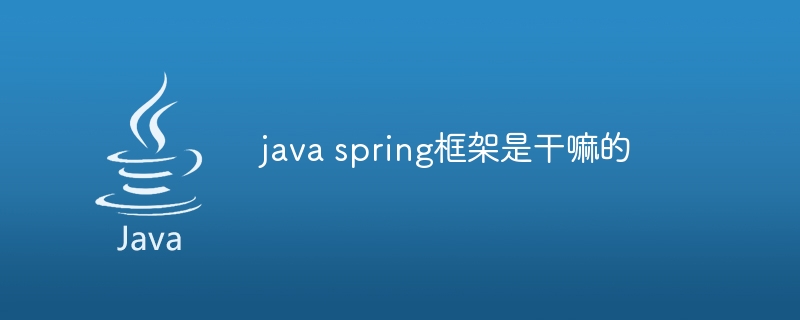Home >Java >javaTutorial >What is the java spring framework for?
What is the java spring framework for?
- 小老鼠Original
- 2023-12-29 15:10:231445browse
java spring framework is an open source lightweight application framework for building enterprise-level Java applications. It provides a wealth of functions and components, including dependency injection, aspect-oriented programming, transaction management, data access, messaging, etc., as well as integrated support for various application layer frameworks. The design goal of the spring framework is to simplify the development of enterprise-level applications, improve code maintainability and testability, and reduce development complexity. The spring framework is widely used in the development of Java enterprise applications.

Operating system for this tutorial: Windows 10 system, Dell G3 computer.
Spring framework is an open source lightweight application framework for building enterprise-level Java applications. It provides a wealth of functions and components, including dependency injection, aspect-oriented programming, transaction management, data access, messaging, etc., as well as integrated support for various application layer frameworks. The design goal of the Spring framework is to simplify the development of enterprise-level applications, improve code maintainability and testability, and reduce development complexity. It also provides great scalability and flexibility, allowing developers to choose appropriate components and features to build applications according to their needs. The Spring framework is widely used in the development of Java enterprise applications.
The main functions of the Java Spring framework include:
Dependency injection (DI): The Spring framework is responsible for managing and injecting components through the dependency injection mechanism. The dependencies between components reduce the coupling between components, making the code more flexible, maintainable and testable.
Aspect-oriented programming (AOP): Spring provides support for AOP, through which cross-cutting concerns (such as logging, transaction management, etc.) can be separated from business logic. Improved code modularity and reusability.
Transaction management: The Spring framework supports declarative transaction management, simplifying transaction configuration and management, and providing programmatic transaction management.
Data access: Spring provides integrated support for various data access technologies, including relational databases, NoSQL databases, JDBC, etc., simplifying data access operations.
Model-View-Controller (MVC): The Spring framework provides a full-featured MVC framework for building Web applications, making it easier for developers to design and implement Web application.
IoC container: The IoC container of the Spring framework is responsible for managing all Java objects in the application, including instantiation, configuration, assembly and management of the life cycle between objects.
Flexible configuration: The Spring framework uses XML, annotation and Java configuration methods, allowing developers to choose the appropriate configuration method to configure applications.
Interface-oriented programming: Spring encourages interface-oriented programming. Through the separation of interfaces and implementation classes, it improves the maintainability and testability of the code.
Test support: The Spring framework provides good support for unit testing and integration testing, making it easier for developers to write and execute test cases.
Overall, the role of the Java Spring framework is to simplify the development of Java enterprise applications, improve the quality, maintainability and testability of the code, while providing a wealth of functions and components, allowing developers to focus more on the implementation of business logic.
The above is the detailed content of What is the java spring framework for?. For more information, please follow other related articles on the PHP Chinese website!

